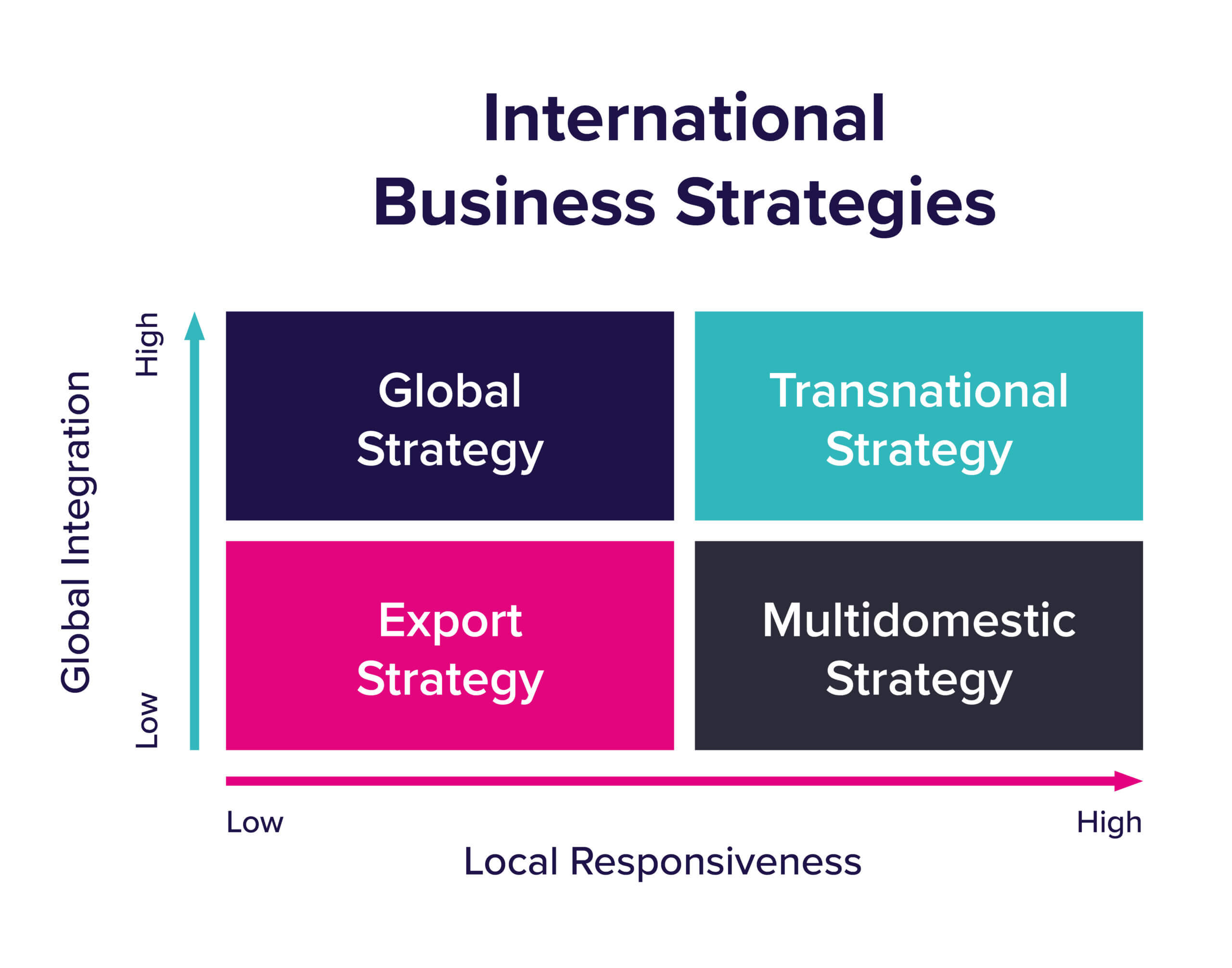In 1902, Rudyard Kipling penned the famous poem “I keep six honest serving men”; their names were ‘What, Why, When, How, Where and Who’. You may be wondering of what relevance this has to internationalisation, but these six pillars of reasoning form the basis of any decision making, and today we explore two of them; ‘Why’ and ‘What’.
The ‘Why’ comes from the drivers behind a company looking to increase international presence, whereas the ‘What’ revolves around the different international business strategy choices a company can make.
We operate within a global economy. Many of the fundamental decisions that TMC make; whether ensuring our studio team consists of talented 3D artists who can sculpt virtual exhibition spaces or investing in cutting-edge technology to ensure our digital meetings happen seamlessly, are influenced by international opportunities.
As many of our clients push towards increasing their international effectiveness, we have taken a closer look at the factors that would influence that decision making, assessing how our in-house expertise could serve as a support system.
Pursuing activities in a new country is a huge decision for any business; whether it be a multinational enterprise (MNE) such as Pfizer or a specialised small or medium enterprise (SME); there is always some degree of risk. Making the move to either go international for the first time or increase internationalisation, can potentially make, or break, a company.

Why pursue internationalisation?
The last two years have been a time of extreme uncertainty for companies that are based in the UK. Brexit has thrown doubt on the ease of British businesses establishing or maintaining operations in foreign markets and COVID has presented unprecedented barriers to success. However, now that the global economy is starting to return to normality, prospects are looking positive for domestic companies as the government has been working hard to secure trade agreements with non-EU countries. 2022 may just present the right time to consider international expansion.
Academically, there are four main drivers behind internationalisation:
- Market drivers- e.g., shared consumer needs
- Government drivers- e.g., reduction of international trade barriers
- Competitive drivers- e.g., competitors are gaining significant amounts from operating in foreign markets
- Cost drivers- e.g., potential gains in scale economies
The exact motives will vary on a company-to-company basis and become clearer after a careful assessment of trends within the relevant market.
Internationalisation for the greater good
Whilst the main focus of most international strategies is to maximise financial success, more often an increasing focus is placed on building a better world.
Many MNE’s have the potential to use their operational scale for positive ends, but finding a ‘real-world’ application of this can often be difficult.
Hologic are a global champion in medical technology that operate across multiple territories. Even at their scale, their social impact is included as a cornerstone of their wider strategy – purpose beyond profit. Amongst other enterprises, their Global Access Initiative aims to improve the access to critical infectious disease testing kits, by providing a cost-effective and financially sustainable program to those in areas of high prevalence, e.g., Gambia and India. Whilst higher revenues could be pursued, deliberate hits are taken to ensure access for all.
We admire the initiatives that Hologic have put in place to attempt to make the world a healthier and better place. TMC places great impetus on inclusivity and strives to work with clients who share the same values.
Which International Business Strategies could I utilise?
The fundamental issue when formulating an international business strategy is to balance the pressures that exist for global integration and those that exist for local responsiveness.

The pressures for global integration encourage a company to coordinate their activities across diverse countries to gain efficient operations. Whereas, if there are high pressures for local responsiveness then a company is encouraged to disperse operations and adapt to local demand.
Read below to explore a brief overview of the international strategies that could provide a framework for each of these considerations.
Export strategy
Influencing factor; distinctive brand
An export strategy blends home country capabilities and innovations, with products in a foreign country.
Companies that already have a strong brand reputation and distinctive capabilities are likely to perform particularly well if they choose an export strategy, as their offering can easily be transferred across different international markets.
Whilst this strategy requires high levels of commitment, there have been many great success stories of businesses that have chosen to follow the export route; Google being one of the most prevalent!
Multi-domestic strategy
Influencing factor; capacity for localised leadership
When a multi-domestic strategy is put into place, a company alters their operations and offering to suit the consumer tastes and buying behaviour in the host country.
In contrast to an export strategy where all decision making is centralised, here localised leadership will make key decisions in the different countries a company operates in. This may mean that despite it being the core operations of one company, their offering and activity may vary from country to country.
Have you ever wondered why Nestle offers so many different flavours of the iconic Kit-Kat in countries such as Japan, compared to the relatively few variations available in the UK? Their use of a multi-domestic strategy has allowed them to cater for localised tastes, but still remain incredibly dominant and retain that strong brand recognition.
Global strategy
Influencing factor; standardised products
As part of a global strategy, all countries are recognised as one large market, meaning a standardised product is offered in all countries of operation and integration is at a maximum.
A company employing a global strategy looks to take advantage of scale economies and exploit local economies across the world, whilst using a standardised offering in all countries they operate in. All decisions in this strategy come from a centralised headquarters, in the company’s domestic market.
If you are looking for a company that is the epitome of a well-executed global strategy, look no further than Ikea. The Swedish company are renowned for having a particularly strong brand, yet they have very little adaption across the 30+ countries they operate in.
Transnational strategy
Influencing factor; staying risk averse
Transnational strategies aim to maximise the advantages of global and multi-domestic strategies, whilst also minimising their risk.
Within this framework, products, services, and operational activities are subject to minimum efficiency standards and adapted to the requirements of each country, maximising learning and innovation across all units.
Considering implementing a transnational strategy can seem like a daunting prospect. Yes, it is a complex strategy to implement, but that doesn’t mean it can’t be successful. If you require reassurance that a transnational strategy is right for you, look no further than McDonalds. They are one of the most recognisable fast food companies in the world, yet you will find they offer an adapted menu in each country they operate in.
Whilst the academic approach to internationalisation sits within these four frameworks, a blended approach to growing beyond borders can often also be successful, dependent on your motivations and drivers.

Case Study: A new era of virtual delegates
The Coronavirus posed many problems to those that operate using a global international strategy. However, times of adversity can offer an opportunity to emerge stronger on the other side.
The European College of Neuropsychopharmacology (ECNP) annual congress was originally planned to take place in Vienna in 2020, but due to the pandemic was migrated online. TMC were approached by ECNP to develop an engaging virtual environment which could serve as a solution to this challenge.
After working closely with ECNP and their partners, the result was a highly interactive virtual environment containing over one-hundred live and pre-recorded videos, all of which could be accessed by medical professionals in ninety-eight countries – a feat unachievable from the equivalent live event. To ensure users would take the same value from the virtual congress as they did from in-person, a critical focus was placed on engagement and user experience.
Case Study: Campaigns that transcend borders
Over the last couple of years, many companies will have experienced disruptions to their manufacturing and supply chains due to wider global issues. Whilst at the time this might seem like it can hinder a company’s progress, however, careful planning and precise execution could instead present an opportunity.
Healthcare and pharmaceutical products are two of a few sectors that experienced steady, if not increased, demand throughout the pandemic. There are many diseases that are prevalent in countries all over the world, with cancer being one of the most destructive. TMC’s longstanding client; Hologic, maintains a product portfolio that includes systems used through from cancer diagnostics to treatment and post-care.
Guiding Hologic through the launch of their 3DQuorum Imaging Technology across Europe, a system which is part of their leading breast healthcare division, TMC were able to navigate the uncertainty of COVID through a core understanding of the niche audience. This was achieved through a fully integrated awareness campaign, with over one-million users being served the campaign content. Despite this taking place during an unsettling economic period, the strategic planning and professional execution of the project led to 130% of the expected impressions.
Internationalisation and your vision
The global environment we operate in is one that is constantly changing. It is crucial to the success of projects that economic factors and social influences are considered when devising solutions to a brief.
The mere knowledge of international strategies doesn’t necessarily lead to success. However, the application and interpretation of the methods to a specific set of circumstances that fits the company’s long-term goals will do.

About the author
Alex joined the team in early September 2021 as Junior Marketing Executive.
Prior to joining TMC, Alex achieved a 2:1 in his Undergraduate Business Studies Degree at Bangor University. Following the completion of his BA, Alex knew Marketing was the discipline he thrived in. This passion led to Alex pursuing an International Marketing MBA, where he accomplished a distinction and set the standard for his ongoing career.
About TMC
With over 16 years of experience, TMC Strategic Communications is an award-winning marketing agency that empowers, educates and builds brands and to deliver a positive legacy.
References
Whittington, R., Regnér, P., Angwin, D., Johnson, G., Scholes, K., Evans, J. and Kerridge, C., 2020. Exploring strategy. 12th ed. Harlow: Pearson education, pp.270-299.
Lovelock, C. and Yip, G., 1996. Developing Global Strategies for Service Businesses. California Management Review, [online] 38(2), pp.64-86. Available at: <https://d1wqtxts1xzle7.cloudfront.net/63140269/Developing_Global_Strategies_for_Service_Businesses20200429-94940-4anv7t-with-cover-page-v2.pdf?Expires=1646049527&Signature=T1MHg2nLe7wVvqnEVlYab8UaIV0gwnKky8CIW0lqAtT-QaO6cDvTWTTVz66-d-498p5a155mdK83bveTRGmQ~cBfrB3Q8Eh1TnSgJjtermcGwsmgiQ1~Hgjvtz56e0oyW7NAhiXMEcQNL-YNS70v6rq8KZYP76Cd2GF7Xcp6W52MRQ4NSA13rKEmT0uVvLYkTl2Q~IFl6GMhqygPisqP0PGKGObGzF8~63A4tcdXfbh4vmqyiFUDA0DMx8xSs6oozXyh8Mh6Cxz3bO1moQp5s5Y4vcfpoZSc3BSnzv2~l9JI4LQMK1sNpD2TyFTkNBRkTwhuDnj8wFlDjSoRWOCgnw__&Key-Pair-Id=APKAJLOHF5GGSLRBV4ZA>.
IESE Business School., 2015. How SMEs Can Internationalize. [online] Forbes. Available at: <https://www.forbes.com/sites/iese/2015/04/20/how-smes-can-internationalize/>.
Lazzari, Z., 2019. What Is a Transnational Business Strategy?. [online] Small Business – Chron.com. Available at: <https://smallbusiness.chron.com/transnational-business-strategy-20950.html>.
Share this
Because you viewed this insight piece,
rnyou may wish to navigate to the following…
